As an Amazon Associate, I earn from qualifying purchases.
Follow this step-by-step tutorial to learn how easy Canning Tomato Soup can be. The ultimate comfort food, this homemade canned tomato soup recipe can be pressure canned or preserved via water bath canning.
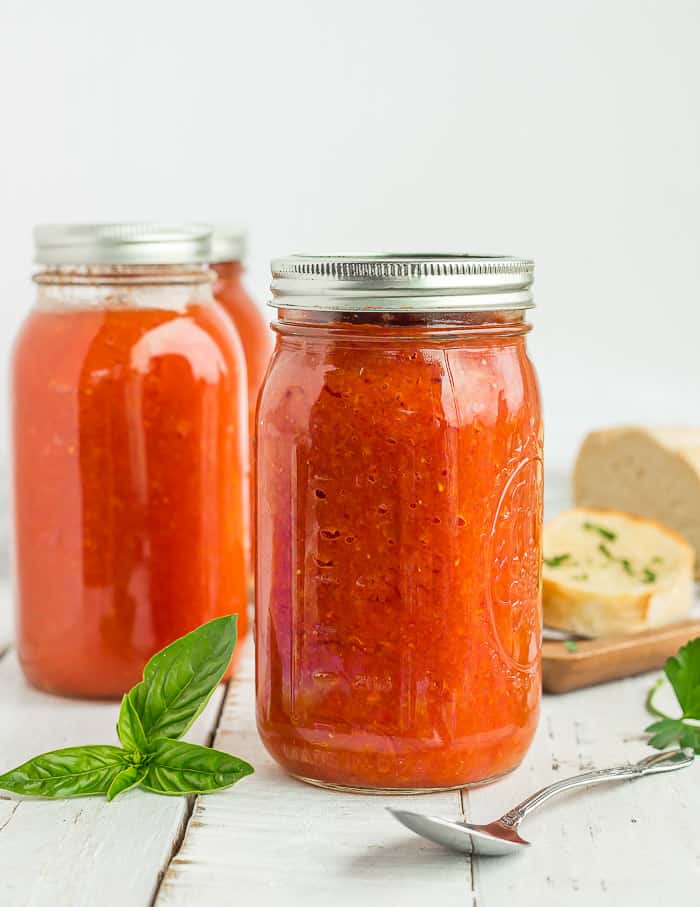
Homemade tomato soup is amazing and tastes so fresh, but peeling and pureeing tomatoes each time you want soup is super time-consuming. Not to mention that tomato season is only about six weeks long in most climates.
So what is a soup-obsessed girl to do? Can her own tomato soup base, of course. Let’s do this!
Which Tomatoes Are Best For Canning Tomato Soup?
Easy answer – whatever tomatoes you have! Paste-style tomatoes are thicker and have fewer seeds, but their flavor is not usually very exciting.
Throughout the growing season, I’m busy canning (whole) tomatoes and canning stewed tomatoes, but I save canning tomato soup for the end of the season when all that is left are the random tomatoes. Random tomatoes make the best soup because you get all the complex amazing tomatoey flavor in one delicious bowl.
You need about 45 pounds of tomatoes for 14 pints or 7 quarts. Since I never have that many at once, I do small batch canning and might produce 1-4 quarts at a time. It all adds up and it all eats the same.
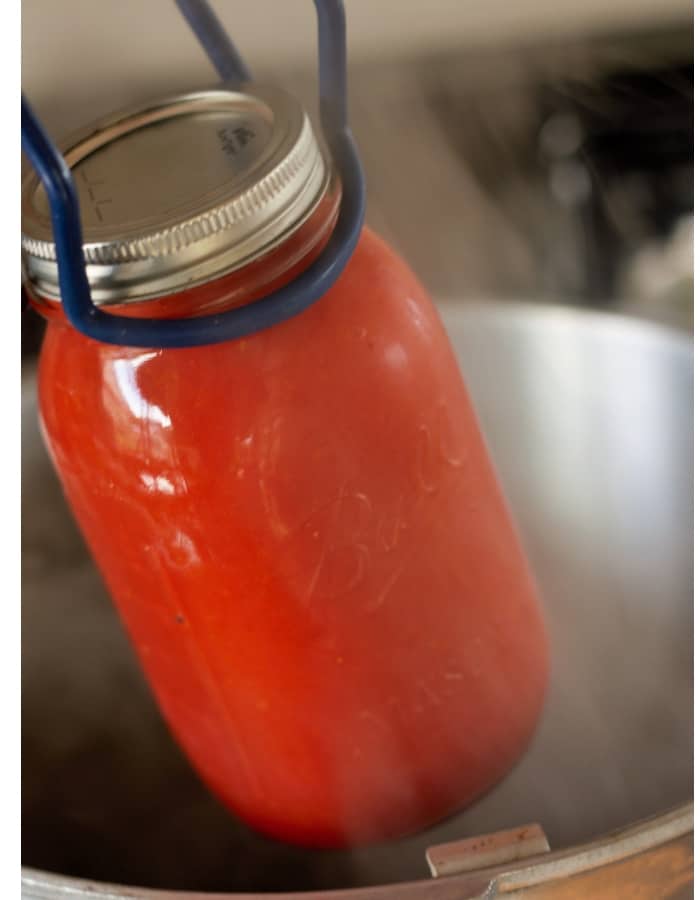
Why Do I Need Bottled Lemon Juice for Canning?
The lemon juice is needed to regulate the acidity of the tomatoes to keep the pH level consistent. Storebought lemon juice generally has the same level of acidity (5%) from bottle to bottle. You don’t get that guarantee with freshly squeezed lemons.
How to Pressure Can Tomato Soup – Step by Step
I’ll walk you through the process here in photos because it really helps, especially if you’re new to canning. At the bottom of the post, you’ll also find a printable and detailed recipe card.
Rinse all your awesome tomatoes and cut them in half. If you have big ol’ tomato chonkers, then cut them into smaller chunks. Add a strainer/colander to a large bowl.
Wash and clean your jars. For canning soup, I recommend quart-sized regular-mouth jars. It is no longer necessary to sterilize jars before canning (hurray!) but you should make sure they are preheated enough to not crack when placed in hot water.
You can put them in a clean dishwasher and run them through a quick wash cycle, or place them in a large pan with some water in a low-heat oven (my lowest temp is 170˚F degrees) until you need them. I’ve even just put super-hot tap water in them before and left them on the counter.
Wash your lids with hot soapy water and place them in a clean bowl for now.
Add the tomatoes to a pot of boiling water and parboil them until you see the skins start to come off one of the tomatoes (about 1-2 minutes). You can read a more in-depth tutorial on How to Blanch and Peel Tomatoes.
Use a slotted spoon and remove the tomatoes and place in the strainer.
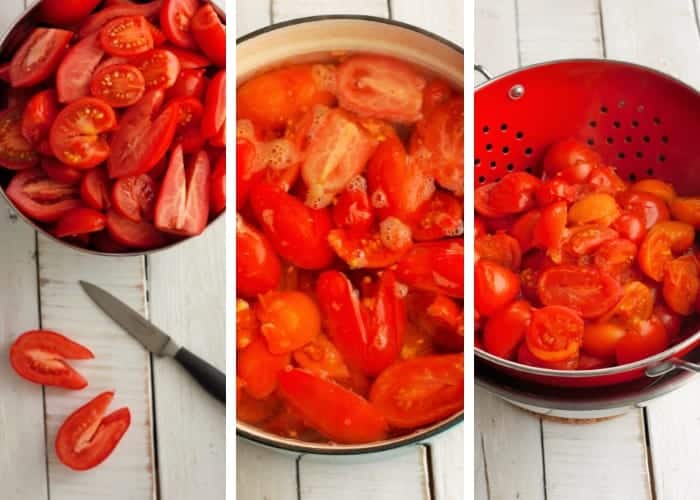
Run the tomatoes through a food mill to remove the seeds and skins. If my tomatoes are particularly watery, I will strain them a bit through a mesh strainer.
Transfer the tomato puree to a pot over low heat or a crockpot set to low. Keep warm until ready to can.
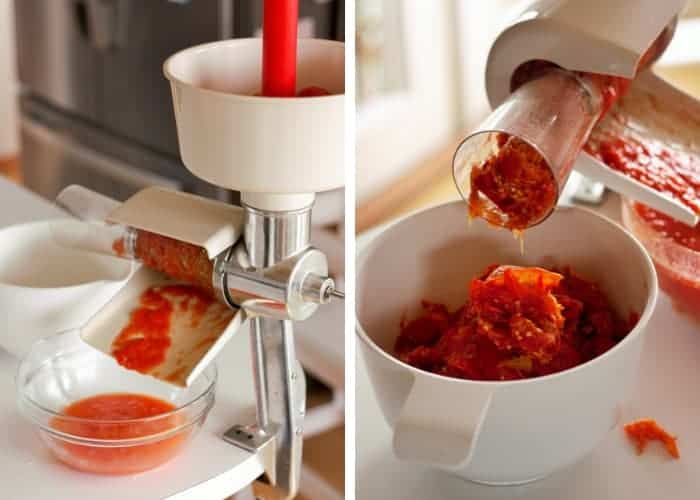
Add 3 quarts of water to your canner and put it on a burner set to high. Make sure there is a canning rack in the bottom of the canner. (Reminder: these are pressure canning instructions. See the instructions below and in the recipe card for water bath canning details).
Place a funnel on a canning jar, add the lemon juice or citric acid, and ladle in the warm tomato puree, leaving 1 inch of headspace. Remove any bubbles from the jar (I use a plastic chopstick).
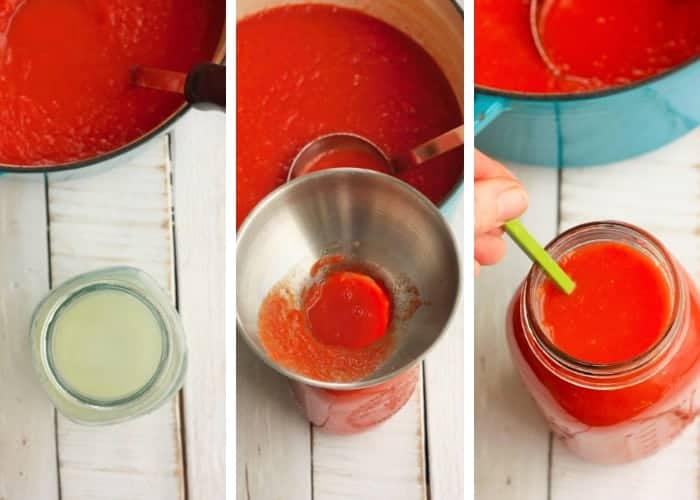
Use a wet clean rag and wipe the rim of the jars to make sure they are free of any food.
Place a clean lid and then a ring on the jar and tighten the ring to fingertip tight (tight enough that it won’t come off, but not so tight that the Hulk couldn’t budge it).
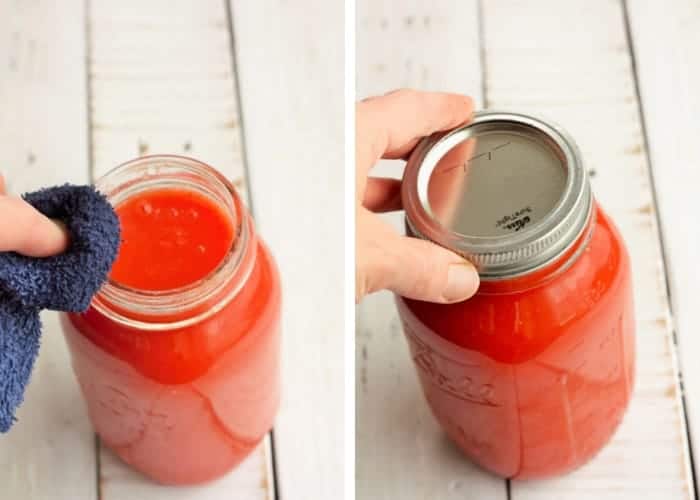
Using canning tongs, place the jars in the canner. If you don’t have enough jars to fill the canner, consider Canning Water in a few jars to stock your emergency drinking water supplies.
Lock the lid. Soon, steam will start coming through the vent pipe (I call it the steam chimney). Allow the steam to pass through for about 10 minutes. Then put the pressure regulator (I call it the chimney cap) on top.
Pretty soon, the air vent will pop up. That is a sign that you’re starting to build pressure inside the canner. Get excited, nerd!
Under normal conditions, tomato soup needs to be pressure canned at 11 pounds of pressure for 15 minutes for both pints and quarts. See chart below for any changes to processing times.
Pressure Canning Tomato Soup in a Dial-Gauge Pressure Canner
| Canner Pressure (PSI) at Altitudes of | ||||||
| Style of Pack | Jar Size | Processing Time | 0-2,000 ft | 2,001-4,000 ft | 4,001-6,000 ft | 6,001-8,000 ft |
| Hot or Raw | Pints or Quarts | 20 mins | 6 lbs | 7 lbs | 8 lbs | 9 lbs |
| 15 mins | 11 lbs | 12 lbs | 13 lbs | 14 lbs | ||
| *Source: National Center For Home Food Preservation | ||||||
Processing Time for Tomato Soup in a Weighted-Gauge Pressure Canner
| Canner Pressure (PSI) at Altitudes of: | ||||
| Style of Pack | Jar Size | Processing Time | 0-1,000 ft | Above 1,001 ft |
| Hot | Pints & Quarts | 20 mins | 5 lb | 10 lb |
| 15 mins | 10 lb | 15 lb | ||
| 10 mins | 15 lbs | Not recommended | ||
| *Source: National Center For Home Food Preservation | ||||
When the dial gauge reaches the appropriate PSI, reduce the burner temp to medium, and start your timer. The pressure must stay at the PSA or (a little bit) above for the duration of the cooking time. You’ll likely need to adjust the temp on the burner a few times depending on your stove.
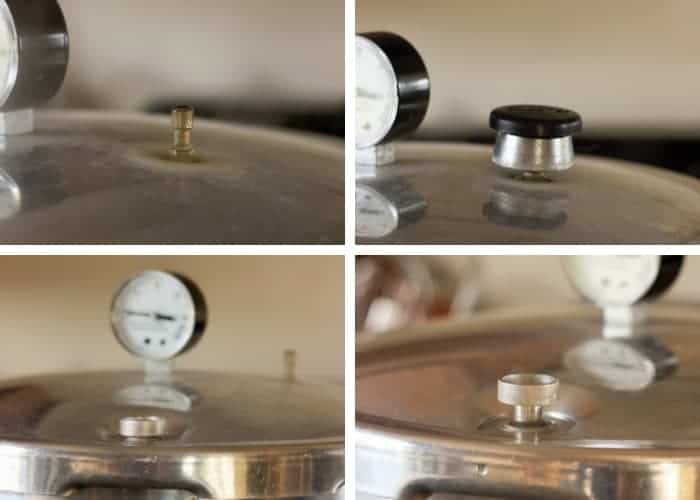
When the time is up, remove the canner from the burner and allow it to sit until you hear a distinctive “click” of the air vent dropping. Remove the pressure regulator and carefully remove the lid of the canner (Pro tip: I always use oven mitts when I take the lid off because the steam is super hot). Let the jars sit in the canner with the lid off for 5 minutes.
Place hot jars on a towel where they can sit undisturbed for 12 hours.
After a few hours, to check for sealing, gently press down in the middle of the lid. If the lid has no give, it’s sealed. If you can press the lid in and it pops a bit, your jars are not sealed.
How to Can Tomato Soup {Water Bath Canning}
Follow all the steps above for blanching, making, and jarring the tomato soup base.
Prepare your water bath canner by filling it with water. You need to have enough water to cover the jars by 1 inch once the water is boiling.
Set the canner on the stove. Turn the burner to high.
Using canning tongs, carefully place your jars in the canner. Put the lid on. Processing times will vary based on altitude. See the chart below. Pro tip: the water must return to a boil in the canner before you can start the timer.
Processing Time for Tomato Soup - Water Bath
| Processing Time for Tomato Soup - Water Bath | |||||
| Process Times at Altitudes of: | |||||
| Style of Pack | Jar Size | 0-1,000 ft | 1,001-3,000 ft | 3,001-6,000 ft | Aove 6,000 ft |
| Hot | Pints | 35 min | 40 min | 45 min | 50 min |
| Quarts | 40 min | 45 min | 50 min | 55 min | |
| *Source: National Center For Home Food Preservation | |||||
Once the jars have been processed for the appropriate amount of time, remove the canner from the burner, wearing oven mitts carefully take off the lid of the canner, and allow it to sit for 5 minutes. Pro tip: I tend to just slide the canner into the middle of my stove, as it weighs a ton.
Carefully remove the jars with canning tongs, and place them on a thick towel in a place where they can be undisturbed for 12 hours.
STORAGE FOR HOME CANNED Tomato Soup
Once the jars have sealed, remove the rings. Label and store sealed jars in a cool (best results are 50-70˚F) dark place for up to 12-18 months.
If you have the space available, do not stack the jars on top of each other more than two jars high.
Why Can’t I Add Spices and Stuff to This Soup?
When you are canning with lower acid foods you don’t want to mess with any of the tried and true and TESTED recipes. Too much of one ingredient or too little of another can throw off the safety of your final product.
Instead, I treat this recipe as a base, much like you would if you bought a can of tomato soup at the store. But when cooking with it, I never just add water; it’s more fun and flavorful to doctor it up.
Check out this recipe for my favorite homemade tomato soup recipe. <— this recipe calls for whole tomatoes but using this tomato soup base allows you to skip the pureeing step.
HELP! WHY ARE MY JARS LEAKING Tomato JUICE?
If you find that juice has leaked out after they have sealed, you have experienced a common canning issue called siphoning. It happens to the best of us!
Siphoning is typically caused by not allowing the jars to rest in the canner after they have finished processing. In the directions, you’ll see that I recommend you remove the canner from the burner, remove the lid, and let it sit for 5 minutes.
This is important as it allows the jars time to rest before being allowed to cool on the counter. Doing this process will significantly cut down on siphoning.
IF YOU HAVE SIPHONING IN YOUR JARS, FOLLOW THESE STEPS:
- Check – are the lids still sealed?
- Look – have you lost less than half of the amount of liquid in the jar?
- Examine – does the tomato soup still look fresh with bright colors?
If the answer to the above three steps is “yes!”, then they are safe to eat.
WHAT IF MY JARS DON’T SEAL?
If you’ve correctly processed your homemade tomato soup, and the lids still didn’t seal, you can reprocess them.
Double-check to make sure there are no:
- Chips in the rim of the jar
- Dried juice or bits of tomato soup on the rim (anything between the rim and the lid may prevent a seal.
Best practices would involve using brand-new lids for reprocessing. Set aside the old lids to use for dry storage (related: Pantry Essentials for the Home Cook).
If the jars don’t seal on the second attempt, you likely have a bad batch of lids, or your canning process has a step missing. Email me and we’ll try to troubleshoot what is going on.
Why Do I Need to Remove All the Seeds and Skins?
Gosh, it would be so much easier to just blend the tomatoes whole, right? Technically you don’t need to remove the seeds and skin, but I find too many seeds will turn your soup completely bitter; what a waste. Skins can also give your final product a weird texture and throw off the taste.
If you’re in a rush, canning whole tomatoes might be more up your alley. And they’re super versatile and easy to use in soups and stews. Or you could even dehydrate tomatoes.
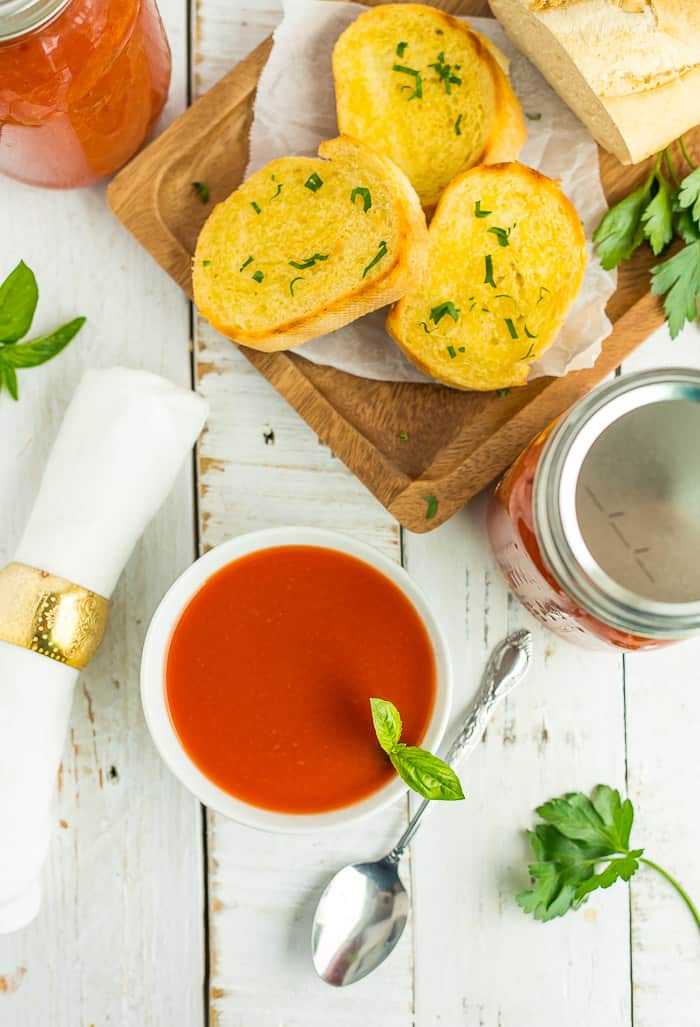
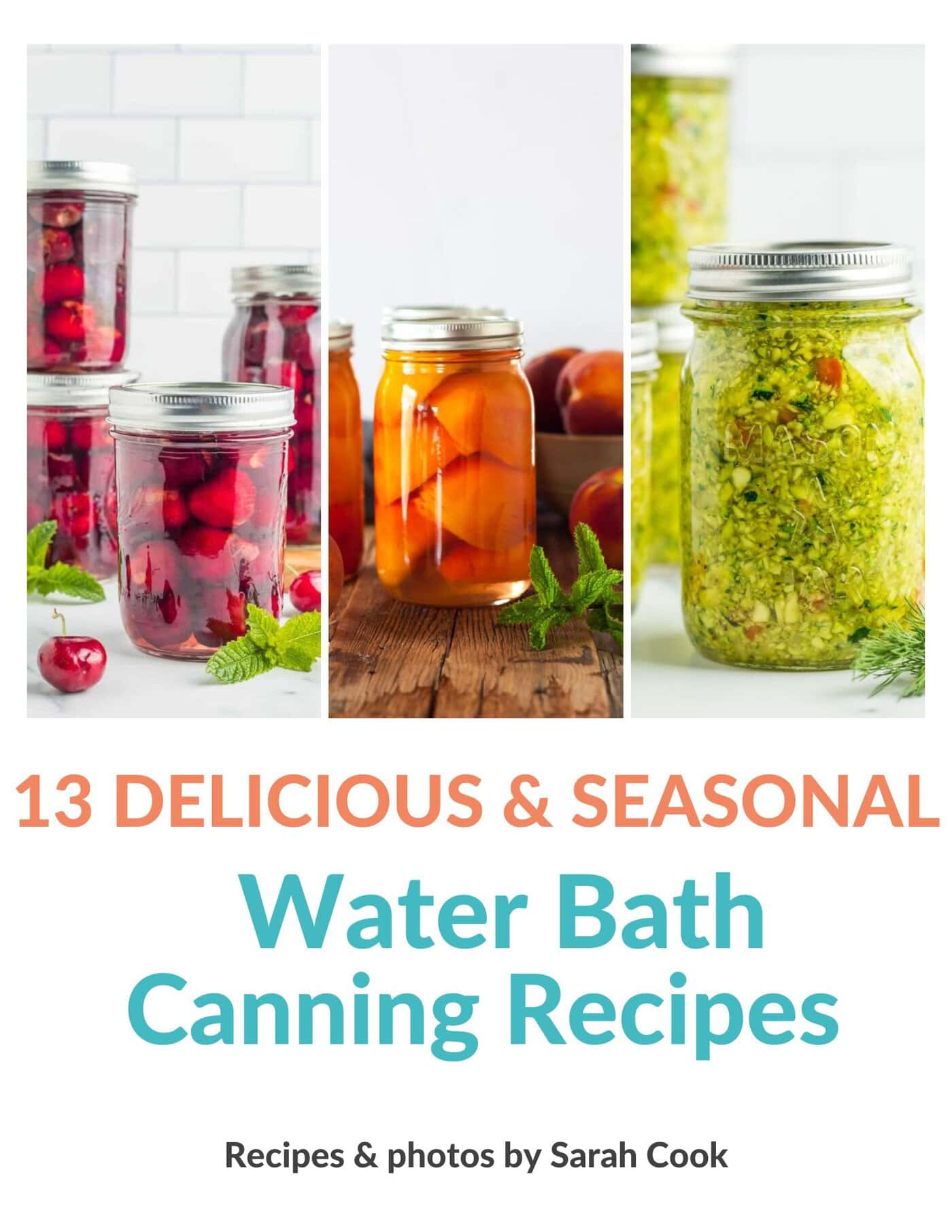
Get my Canning e-book!
It’s 51 pages of every helpful tip and trick you could want as a brand new canner, AND it includes 13 ad-free canning recipes that are designed to take you from novice to pro.
Canning Tomato Soup Base
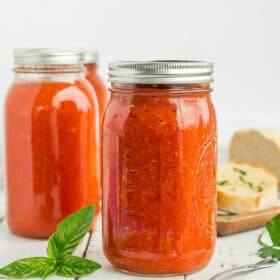
Equipment
Instructions
Pressure Canning Tomato Soup
- Rinse the tomatoes and cut in half, or quarters for larger tomatoes.20 lbs tomatoes
- Add a strainer/colander to a large bowl.
- Wash and sanitize your jars. You’ll want to keep them warm to avoid having them crack when placed in the canner. You can fill them with hot water, or place them on a tray in the oven at 170F.
- Wash your lids with hot soapy water and place them in a clean bowl for now.
- Add the tomatoes to a pot of boiling water and parboil them until you see the skins start to come off one of the tomatoes (about 1-2 minutes).
- Use a slotted spoon and remove the tomatoes and place in the strainer.
- Run the tomatoes through a food mill to remove the seeds and skins.
- Transfer the tomato puree to a pot over low heat or a crockpot set to low. Keep warm until ready to can.
- Add 3 quarts of water to your pressure canner and put it on a burner set to high. Make sure there is a canning rack in the bottom of the canner.
- Add lemon juice or citric acid to your canning jars.Quarts: 2 tbsp lemon juice OR 1/2 tsp citric acid. Salt (optional) 1 tspPints: 1 tbsp lemon juice OR 1/4 tsp citric acid. Salt (optional) 1/2 tsp10 tbsp lemon juice
- Place a funnel on a canning jar and ladle in the warm tomato puree, leaving 1 inch of headspace. Headspace is defined as the space between the top of the food and the top of the jar.
- Using a long utensil (I prefer a plastic chopstick), remove all the air bubbles from the jar.
- Use a wet clean rag and wipe the rim of the jars to make sure they are free of any food.
- Place a clean new lid on the jar. Add a ring, and tighten to fingertip tight.
- Using canning tongs, gently place the jars in the canner.
- Lock the lid. Soon, steam will start coming through the vent pipe. Allow the steam to pass through for about 10 minutes. Then put the pressure regulator on top.
- Pretty soon, the air vent will pop up.
- In a dial-gauge pressure canner, process pints and quarts based on the elevation guide below:*0-2,000f ft {PSI: 6 lbs of pressure} = Pints & Quarts 20 min*0-2,000f ft {PSI: 11 lbs of pressure} = Pints & Quarts 15 min*2,001-4,000k ft {PSI: 7 lbs of pressure} = Pints & Quarts 20 min*2,001-4,000k ft {PSI: 12 lbs of pressure} = Pints & Quarts 15 min*4,001-6,000k ft {PSI: 8 lbs of pressure} = Pints & Quarts 20 min*4,001-6,000k ft {PSI: 13 lbs of pressure} = Pints & Quarts 15 min*6,001-8,000k {PSI: 9 lbs of pressure} = Pints & Quarts 20 min*6,001-8,000k {PSI: 14 lbs of pressure} = Pints & Quarts 15 min
- When the dial gauge reaches the appropriate PSI, reduce the burner temp to medium, and start your timer. The pressure must stay at the PSI or (a little bit) above for the duration of the cooking time. You’ll likely need to adjust the temp on the burner a few times depending on your stove.
- When the time is up, remove the canner from the burner and allow it to sit until you hear a distinctive “click” of the air vent dropping. Remove the pressure regulator and carefully remove the lid of the canner (Pro tip: I always use oven mitts when I take the lid off because the steam is super hot).
- Let the jars sit for 5 minutes in the canner and then lift them out with canning tongs. Pro tip: allowing the jars to sit in the canner with the lid off can help reduce the siphoning of liquid in your jars.
- Remove with canning tongs and place on a towel where they can sit undisturbed for 12 hours.
- After a few hours, to check for sealing, gently press down in the middle of the lid. If the lid has no give, it’s sealed. If you can press the lid in and it pops a bit, your jars are not sealed.
Water Bath Canning Tomato Soup
- Complete steps 1-8 above.
- Fill your canner so that there will be 1 inch of water over the tallest jar that you are canning. Set it on a large burner set to high.
- Complete steps 10-14 above.
- When the water has reached a rolling boil, place the jars in the canner and place the lid on top.
- Process pints and quarts based on the elevation guide below:*0-1,000 ft – Pints =35 min Quarts =40 min*1,001-3,000 ft – Pints =40 min Quarts =45 min*3,001-6,000 ft – Pints =45 min Quarts =50 min*6,000 ft+ – Pints =50 min Quarts =55 min
- When the time is up, remove the canner from the burner and let the jars sit for 5 minutes in the canner and then lift them out with canning tongs.
- Place on a towel where they can sit undisturbed for 12 hours.
Notes
- Typically, 45 pounds of tomatoes will make 14 pints or 7 quarts of tomato soup.
- This tomato soup can be frozen in wide-mouth canning jars. Leave 1 inch of headspace in the jars to allow for expansion during freezing. Allow to fully cool in the jar before freezing.
- Your soup may separate in the jars after canning. This is totally safe as long as the jars are sealed. This is the result of using tomatoes with higher water (juice) content.
- Once the jars have sealed, remove the rings. Label and store sealed jars in a cool (best results are 50-70˚F) dark place for up to 12-18 months.
Nutrition
Nutrition information is automatically calculated, so should only be used as an approximation.

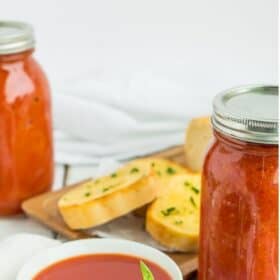
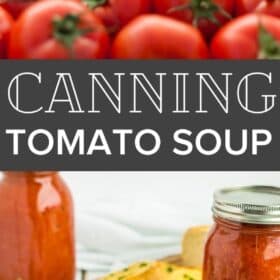
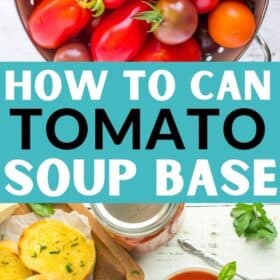

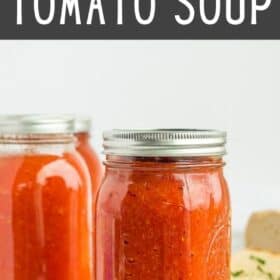

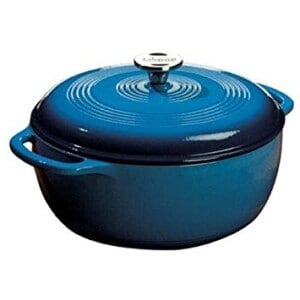

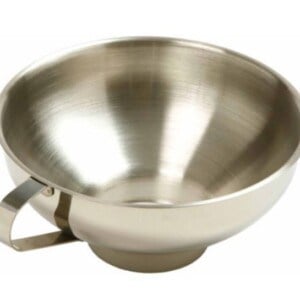
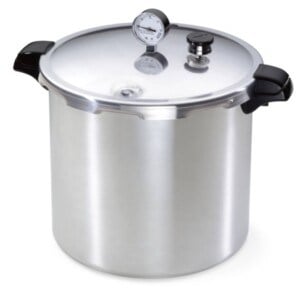
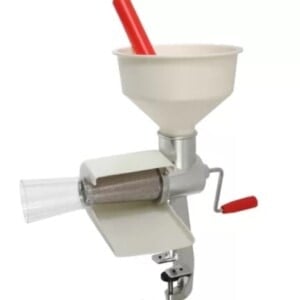
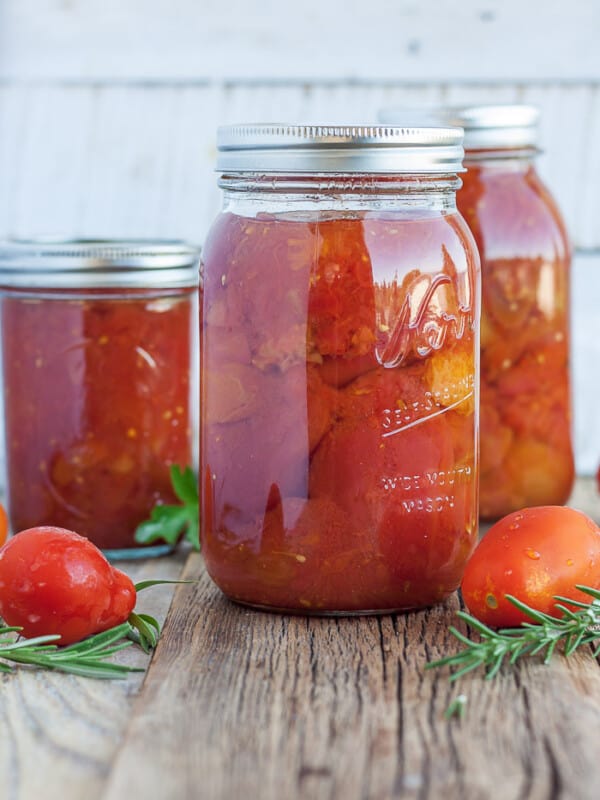
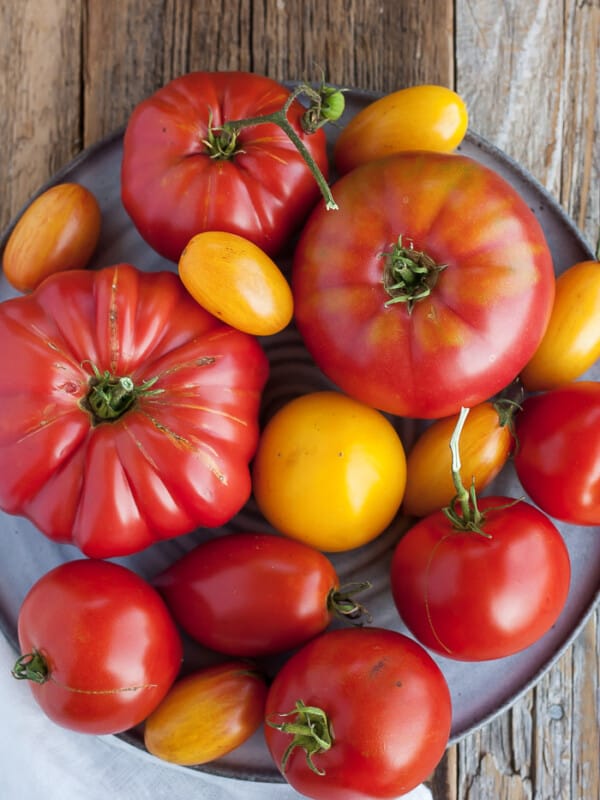
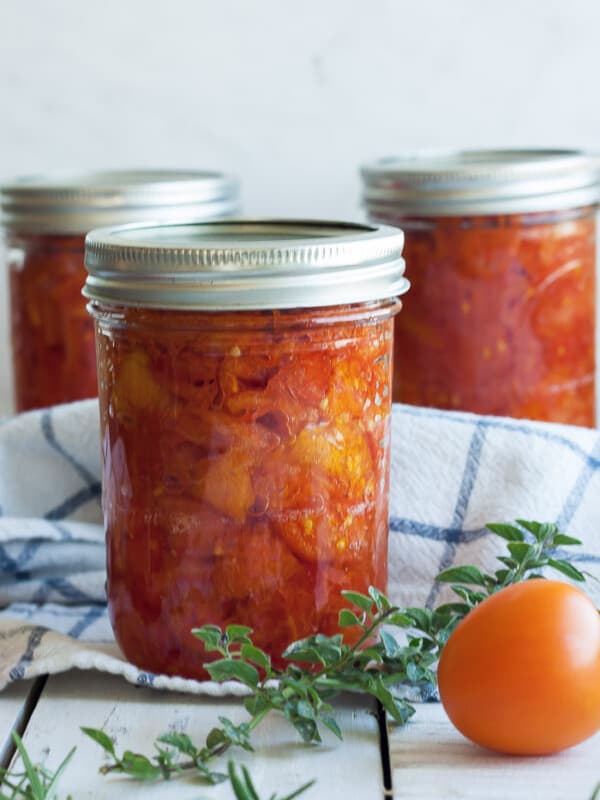
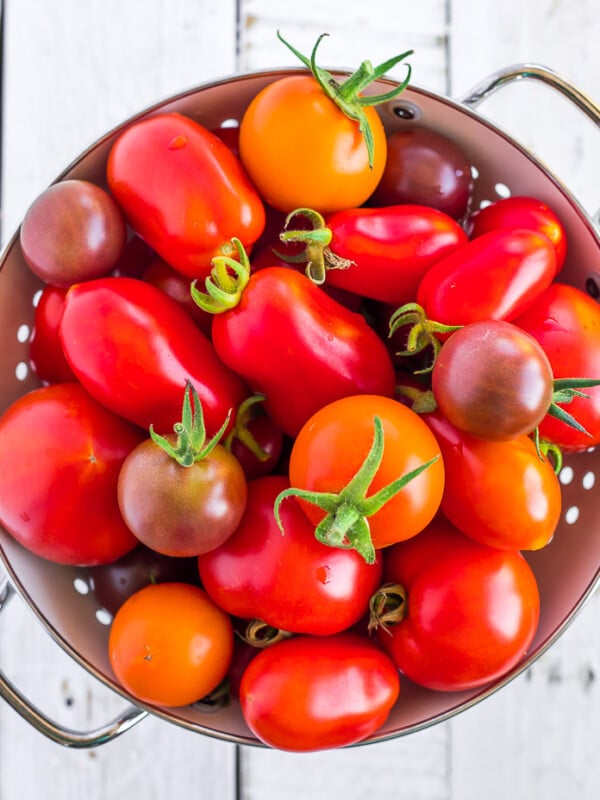

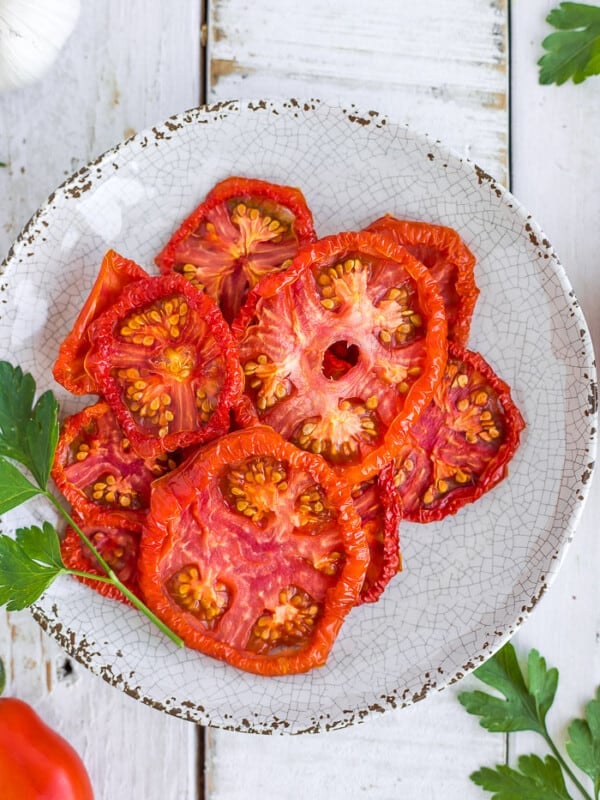






This is NOT a tomato soup recipe. It’s recipe to can tomatoes. You don’t even give recipe that uses the base
Hi Ed, I actually do give a link to a recipe that uses the base. It’s listed in the post and hyperlinked and highlighted with a giant blue box around it so that people can’t miss it. Let me copy and paste it below for you:
Why Can’t I Add Spices and Stuff to This Soup?
When you are canning with lower acid foods you don’t want to mess with any of the tried and true and TESTED recipes. Too much of one ingredient or too little of another can throw off the safety of your final product.
Instead, I treat this recipe as a base, much like you would if you bought a can of tomato soup at the store. But when cooking with it, I never just add water; it’s more fun and flavorful to doctor it up.
Check out this recipe for my favorite homemade tomato soup recipe. <— this recipe calls for whole tomatoes but using this tomato soup base allows you to skip the pureeing step.
Can I roast the tomatoes (without spray or oil) pinch off skins and run through a mill and pick up at step 8?
Absolutely, Becca! They will taste extra delicious that way too.
Is it normal for the tomato sauce to be spewing under the ring when I remove it from the hot water bath? I’ve never has that happen before.
Hi Mariann, it sounds like you are experiencing siphoning. That typically happens when the boiling is inconsistent during the canning process, and/or when the jars are instantly removed from the canner after they have finished.
If you look in the printable recipe card, under “Water Bath Canning Tomatoes”, you’ll see in step 6 that you leave the jars in the water with the lid off for 5 minutes after they have fully processed. That helps everything regulate a bit before removing them, which can cut down on siphoning.
Another potential reason for the soup to be siphoning is that proper headspace wasn’t allowed when filling the jars. For tomato soup base, you need a full 1-inch between the top of the soup and the top of the jar.
Is it table salt or pickling that you need to use
Hi Wendy, you can use either for this recipe. Canning/pickling salt is only important when you are canning something that has a clear brine. Table or kosher salt can cause clear liquids to get cloudy when canned.
when water bathing tomatoe soup, is it ok if the liquid (water) from the tomatoes falls to the bottom to the jar after canning and the thicker part of the sauce stays on top of the jar? It’s almost like there’s a separation of liquid. Yes, I did use lemon juice in each jar and I followed a canners recipe to the letter, except for the type of tomatoes I used…she used
Roma’s, and I used beef steak. I did remove most of the seeds and all of the skin first.
Oh yeah, that’s totally fine! And it happens allllllll the time. We call it “tomato pee” in our house. 🙂
Beef steak tomatoes are higher in water content than romas and thus your tomato puree let out a lot more water when they were canned.
Disappointed that you tell how to make a soup base, but then don’t tell what to add to actually make a tomato soup. I clicked on the recipe for tomato soup and that was for use with canned whole tomatoes.
KkAREN, yes that recipe uses whole canned tomatoes BUT in that recipe, you blend them. Using this base allows you to skip the blending step. Use the recipe as a guideline for spices/flavoring and simply skip the blending step.
I am not familiar with your canner so maybe the jars are above the water as they should be.Water does not compress , air does. If your user manual says 3 qts water then so be it but I’m thinking it says one.I’ve been doing this around 40 yrs so I’m no novice.
Hi Charles, yes my canner’s instructions do specifically say 3 quarts of water. I’m using a Presto pressure canner which is probably the most popular pressure canner in the United States.
Additionally, The National Center for Home Food Preservation suggests that at least 3 quarts of water is needed in a pressure canner. They call for 2-3 inches of water in the canner, and I cannot think of a single large pressure canner that would be so shallow and narrow that only one quart produces 2-3 inches of water. While you are definitely not new to the canning process, it appears that best practices have been updated in the last 40 years.
I’ll copy and paste the specific portion of their instructions below and then the link after that.
“Put the rack and hot water into the canner. If the amount of water is not specified with a given food, use enough water so it is 2 to 3 inches high in the canner.” (source)
Sorry but I stand by my statement. this is deceptive as it is not a soup recipe as the site lead one to believe.
The post and recipe is literally called “Canning Tomato Soup BASE”. Which dictionary.com defines as: “the principal element or ingredient of anything, considered as its fundamental part” (source).
Have a great day, Ed!
How do I process tomato s0up made with celery and onion and white beans that I add for fiber and thickening?
Hi Patricia, I responded to your previous comment a few hours ago letting you know it isn’t safe to can a non-tested recipe with additional ingredients. You can however freeze it.
I make tomato soup with some white beans in it for extra fiber and thickening. I want to can the soup but am not sure how because of the beans. I also use celery and onions in my soup.
When it comes to home recipes, it is best to not can them. For safety purposes, it is recommended you only can recipes that have been PH tested for safety.
That being said, I freeze soup all the time, and your recipe sounds like it is a good candidate for freezing!
If I forget the lemon juice, is all lost?
It is meant as a fail-safe preservative. It’s pretty important. I’m sorry because I know that’s not what you wanted to hear!
I froze a bunch of homegrown tomatoes (using your method of freezing whole) at the end of last summer with the plan to make tomato soup. Do the instructions change at all for frozen whole tomatoes? I don’t imagine they will be easy to cut in half before parboiling… what do you recommend?
Jennifer, as frozen tomatoes thaw, the skins slip right off. The insides get super mushy and unless you have giant tomatoes, you probably won’t need to do anything else to them. Once thawed, I bet they’ll be perfect for running through a food mill.
I have 25 Lbs of tomatoes to use, and you just gave me the perfect idea for those tomatoes. My question is, what does a person use to “dr it up” to make it like tomato soup after you have opened up a jar? Any suggestions, because I have no clue? Thanks for the soup base instructions!!
Tina, I basically make this recipe when I open a jar but use the base instead of the whole tomatoes: https://www.sustainablecooks.com/tomato-soup/
Happy canning!
This will be a perfect base for cream of tomato soup! Heading out to get more tomatoes today. I will use the SOS (Soup or Sauce) mix from UtahState coop extension as an add in when heating up this home canned tomato soup base. So happy to have found this 🙂 Blessings – be safe during this crazy time.
Mmmmm, cream of tomato soup sounds delicious!! A perfect cozy fall and winter meal.
This is just tomato sauce. I made tomato soup using all the tomato skins and all. Put the whole cut up tomato’s in my vitamix and it blended it totally up. No seeds or peels left. Then I added some spices to taste like tomato soup. It is so good. And yes I added some lemon juice and heated the soup before pressure canning it. I’m allergic to gluten and dairy so I make all my own soups to can.
Hi Lori, thanks for sharing how you make yours! Sounds delicious.
This recipe is for a base for canning tomato soup. I encourage people to doctor it up how they like when they open a jar. It’s also safer to can a “base” for people who don’t have a pressure canner or are new to canning. You’ll find these notes in the post:
When you are canning with lower acid foods you don’t want to mess with any of the tried and true and TESTED recipes. Too much of one ingredient or too little of another can throw off the safety of your final product.
Instead, I treat this tomato soup as a base, much like you would if you bought a can at the store. But I never just add water; it’s more fun and flavorful to doctor it up.
This Whole30 Tomato Soup recipe is my all-time favorite. You can use this home-canned tomato soup in place of the whole tomatoes in that recipe.
Hi does this recipe require salt ,and if not,why?
Donna, you can certainly add it if you’d like, but it isn’t necessary to keep the product safe.
I prefer to not salt it prior to canning because it allows me to use it in recipes later that may not require additional salt.
The soup mix kind of separated when I canned it, so it looks like water on the bottom half. Is that normal?
Yep, totally normal. It is usually a result of using tomatoes that have higher water content. I call it “tomato pee”. 🙂
Tomato anything aggravates my arthritis 🙁 So I don’t like tomato soup.
Is it just tomatoes or all nightshades? Have you ever looked into them as a food group? I ask because my friend has nightshade issues and all the things that count as nightshades really surprised me!
It seems to be any concentrated tomato, raw onion and raw peppers. I can eat the onions and peppers if they’re cooked well and fresh Roma tomatoes. The more acidic variety of tomatoes the worse it is. I’ve never eaten eggplant and potatoes are just fine for me. I also have no problem with cayenne pepper powder and paprika powder, the little I do eat of it. So spaghetti sauce and pizza sauce are out for me. I can have pizza with VERY little sauce on it.
How frustrating!!
The two nightshades that surprised me were cashews and tobacco.
Timely blog. We are planning to put up tomato juice/soup this weekend. I have been freezing the tomatoes as they come ripe and figure there must be 35-40 pounds by now so it’s time.
Oh, I love freezing tomatoes to process all at once! Happy canning this weekend!